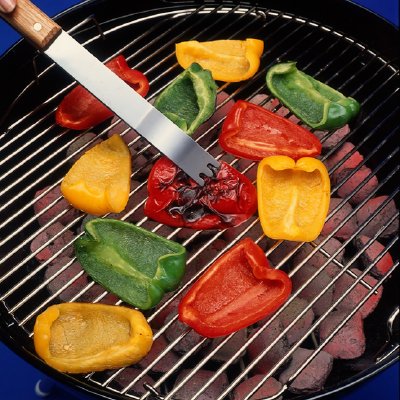Now that you have a garden full of peppers, it's time to harvest and serve them. With all peppers, look for a glossy sheen and no shriveling, cracks, or soft spots. Bell peppers should feel heavy for their size, indicating fully developed walls.
Sweet peppers have no capsaicin, hence no heat. They do have a pleasant bite, though. Bell peppers are most common. Green peppers are simply red or yellow peppers that haven't ripened. As they mature, they turn various shades until they become completely red. Once ripe, they are more perishable, so they carry a premium price. But many people favor the milder taste that these varieties provide. Cubanelles, Italian frying peppers, are a bit more intense in flavor and are preferred for roasting or sauteing.

Bell peppers are perfect for grilling.
|
Hot chili peppers, or chilies (the Mexican word for peppers) are popular worldwide. Ripe red ones are usually hotter than green ones. Still, shape is a better indicator of heat than color. Rule of thumb: the smaller, the hotter.
For example, the poblano, or ancho, chile is fatter than most peppers and only mildly hot. Anaheim, or canned "green chilies," are also fairly mild. Jalapeno is a popular moderately hot pepper. Among the hottest are cayenne, serrano, and tiny, fiery habanero.
Store sweet peppers in a plastic bag in your refrigerator's crisper drawer. Green ones stay firm for a week; other colors go soft in three or four days. Hot peppers do better refrigerated in a perforated paper bag.
Preparing and Serving Peppers
To cool the fire of hot peppers, cut away the inside white membrane and discard the seeds. Wash hands, utensils, and cutting boards with soap and water after handling them and use gloves to prevent the oils from irritating your hands. Avoid touching your eyes while handling peppers.
Bell peppers are delicious raw. They develop a stronger flavor when cooked; overcooked, they are bitter.
What to do if you swallow more than you can handle? Don't drink water; it spreads the fire around your mouth, making the heat more intolerable. Research from the Taste and Smell Clinic in Washington, D.C., has revealed that a dairy protein, casein, literally washes away capsaicin, quenching the inferno; so milk is your best bet. If you don't have any milk on hand, eat a slice of bread.
When that healthy dish needs a little extra color and punch, add interest to your menu with a wide variety of peppers to fit every taste and heat tolerance.
Sure, peppers look and taste great, but they're also good for you. In the next section, we'll talk about the health benefits of peppers.
Want even more information about sweet and hot peppers? Try these links:



